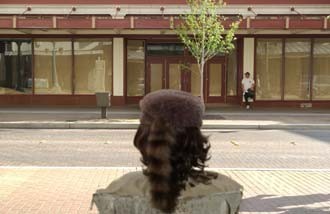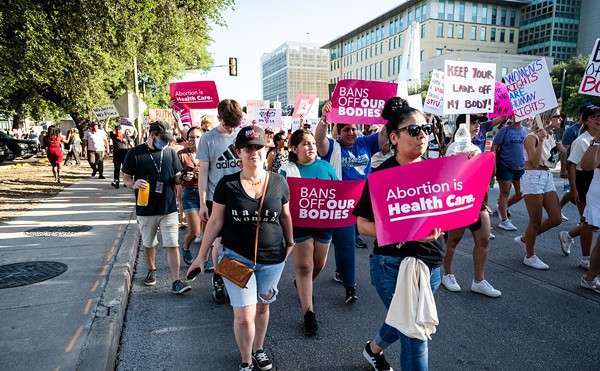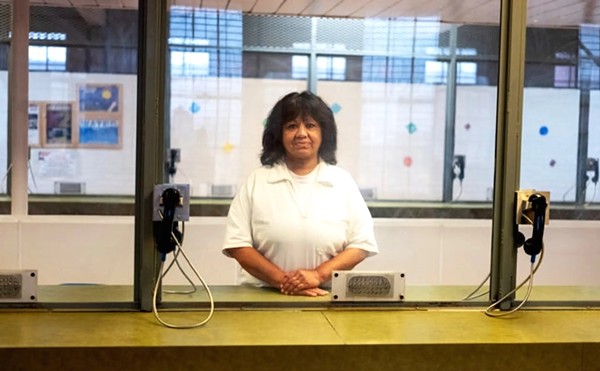| A mannequin adorned with a Davy Crockett coonskin cap keeps watch over the empty storefronts on Houston Street from the entrance to Echoes From the Past, an antiques and collectibles shop. It is one of the few businesses on the block just west of Alamo. Photo by Mark Greenberg |
San Antonio has marketed those attributes to tourists, but now it is trying to sell downtown to the locals. For the past 18 months, a jittery economy, stratospheric gas prices, and the war in Iraq have dented tourism, nationally and locally. To offset the downturn, Downtown Alliance, an advocacy group for downtown businesses and developers, is trying to lure residents from Loopland to the city center - not only to spend money, but also to set up shop and live.
Yet Downtown Alliance faces several formidable challenges. In becoming Texas' No. 1 tourist destination, Downtown San Antonio has choked on its own success. Residents, even those who live inside Loop 410, despise groping their way through throngs of River Walk tourists, inching down Market Street behind charter buses, or paying $7 a day to park.
Business rents run about $3-per-square-foot (to buy space, prepare to cough up $100-per-square-foot), and a dinky apartment can go for $800-$1,000 a month. Few San Antonians can afford to open a shop or live in the city's core - leaving the vacancies for the Gaps, TGIFs, and Starbucks, whose sameness undermines what sells San Antonio in the first place - character.
Behind the movie set of the tourist district, where locals can avoid the crush of the River Walk, downtown's fringes look frayed, as if money has been poured into beautifying a few square blocks, at the expense of north Broadway, East Houston, and West Commerce streets.
Ben Brewer, Downtown Alliance's executive director, agrees downtown needs to redefine itself if locals are to rediscover it. "It gets a little bit nuts at times," he says of the River Walk's subterranean frenzy. "A lot of it is creating balance between new development opportunities and not taking away from the River Walk, but complementing it."
For the past 35 years, most U.S. cities have watched dejectedly as many of their downtown residents fled to the suburbs, seeking space, security, and schools. (Ironically, so many people flew the coop that their nests have become as crowded and unsafe as the ones they abandoned in the city; you, too, can get a doobie on the far Northside.)Yet, the rush back to the center hasn't happened.
"Fifty years ago, everyone was in the habit of going downtown," Brewer says. "We're several generations out of that habit, and services have moved to where people live.
"Successful healthy downtowns favor urban centers with people living in them," Brewer adds. "Residents make sure their neighborhood is safe, clean and well-lit. We've decided no one area of development could have a more long lasting positive effect."
Yet, a lack of services prevents people from living downtown, as do the high rents. The Andalusia condominiums, King William lofts, Exchange Building apartments contain lovely spaces, but none of it affordable for families or even middle-class couples. The main opportunity for families to relocate downtown rests with the dubious San Antonio Housing Authority, which will break ground this summer for a combination of market-rate and affordable housing on the old Victoria Courts site.
Several former hotels, such as the Robert E. Lee, offer small, low-income apartments. Along Broadway, the Calcasieu building provides cheap, but cramped efficiencies and one-bedrooms. "We've had people come in here and ask to sell their furniture because they couldn't fit it in the door," says Joe Earl, co-owner of Echoes From the Past on East Houston Street.
Except for banks and a Walgreen's Drug Store, few basic services exist downtown: There is one hardware store on the west end, no laundromats, and most notably, no grocery. "Everything downtown is something you don't need," says Ann Earl, co-owner of Echoes From the Past. "It is all luxury items."
On the business side, Houston Street is a lesson in urban mismanagement, and the remaining shopkeepers, many of them local, are paying the price. The street should be downtown's main east-west artery, but vacant storefronts and high turnover have funneled the foot traffic elsewhere. The entrance to Houston and Alamo streets greets visitors
| "Everything downtown is something you don't need. It is all luxury items." - Ann Earl, co-owner, Echoes From the Past |
"It's a beautiful street, but there's a big gap between my street and the Majestic," explains local shopkeeper Claudia Romano Cary. "That corner `at Houston and Alamo` really hurts us. I'm afraid those spaces will only be available for the big chains. In a way it would bring business, but it would also take away from the cultural flavor, and the rents would skyrocket and the rest of us would be pushed out of the way."
A former teacher at Samuel Clemens High School, Cary says that when she planned field trips for her students she often asked who had been downtown. "Hardly anybody had come. I think it's because there's not enough noise being made about beautiful things I can find there. The city pushes the Alamo or the River Walk and that's it."
One man, who asked not to be identified, owns a gallery on East Houston. He notes that when he asked about renting a nearby space, a real estate broker told him that the building owner would be entitled to 11 percent of his sales. "I think they want to get rid of us," the man says. "And then they can have the whole block."
Continue to Houston and Broadway: With its empty tables, Atlantis looks like aliens landed and scooped up the patrons; next door, the former Tawril's, gone, and next to that, Pay Less Drug, vanished. Wildlife Exhibit across the street, empty. At Houston and Jefferson, Stuart's, poof.
At Houston and Navarro, the Frost Bros. building has openings, as do the spaces surrounding Bohanan's restaurant. Not until the Majestic Theater does Houston reach semi-consciousness, blinking along the way to the Alameda Theater, a dazzling work-in-progress on West Houston.
Storeowners on East Houston contend they have tried to help themselves. Earl says she tried for three weeks to reach City Councilman Bobby Perez, whose District 1 includes downtown, about holding a regular Houston Street festival. He never returned her call, she says. "We're all in the same boat down here," she explains. "We're down here waiting for the city to help us."
As part of its plan to reinvent downtown in the minds of San Antonians, Downtown Alliance wants to extend and redefine its boundaries. "I look at those areas and see incredible opportunities for fairly dense development," Ben Brewer says. "That's where opportunity for housing is, in those edges. I'm looking there as opposed to the River Walk."
Yet, travel a few blocks beyond the movie set of the tourist district and you will see how the dollars and planning have been funneled to the core, only to neglect the fringe. With expanses of vacant car dealerships, boarded-up buildings, and housing ruins, Broadway north of downtown to Mahnke Park should be renamed Desolation Row. Drive Houston Street east past the ghostly St. Paul's Square, towards the SBC Center, and the pavement is a chuckholed washboard - until you get within two blocks of the Spurs' shrine, then suddenly the road is so smooth a doctor could circumcise a newborn in the back seat of your car.
These fringe areas have potential, said Trinity University economics professor Richard Butler, but urban barriers prohibit their development. "They talk about making St. Paul's Square a vital district, but it's outside the pedestrian walkway. There is a visual barrier created by the interstate."
To attract locals to the city's core, Downtown Alliance and City leaders have to create another world - one above ground that serves residents' needs. It's worth the effort - on both the City's behalf and the locals' part. Despite the financial hardships, Echoes From the Past has lasted 12 years, through street closures, sidewalk renovations, and rotating tenants next door and across the street. With the vibrancy that downtown offers, Earl wouldn't consider moving to Loopland. "We love downtown," she says. "I want to get people down here. If you came and stayed awhile you would love it." •


















